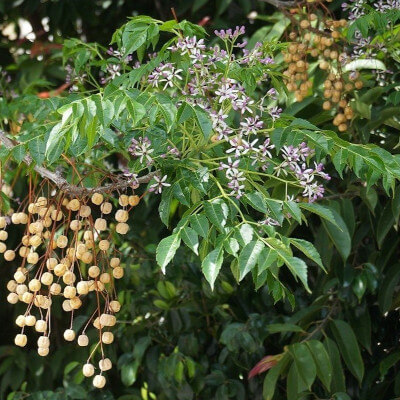
The white cedar, or Melia azedarach, is a majestic species native to the tropical and subtropical regions of Asia. Often referred to as the “Persian Lilac” due to its delicate, fragrant blossoms, this ornamental tree is admired both for its graceful appearance and its wide-ranging uses. At the heart of the Au Bois Vert botanical garden, it stands out with its finely divided leaves and clusters of soft purple flowers that bloom in spring, creating a picturesque scene in Ivato, near Antananarivo.
Melia azedarach, or white cedar, can grow up to 15 metres tall, with a slender profile and dense foliage that provides much-needed shade in sunny areas. Its golden drupes hang in tight bunches, adding visual interest even when it’s not in bloom. The tree is adaptable to various soil types but thrives best in well-drained soil and warm climates—making it an ideal addition to locations such as the Au Bois Vert lodge and restaurant.
Beyond its ornamental appeal, the white cedar plays an important ecological role. It supports biodiversity by offering shelter to numerous bird and insect species. Its resilience in poor soils and dry conditions also makes it a valuable species for reforestation and environmental restoration.
With its stunning display of flowers between March and May, the Margosa transforms the landscape around the Au Bois Vert restaurant, bringing a refreshing and poetic charm to its natural surroundings.
Plant use
The white cedar, or Melia azedarach, is far more than a decorative plant. For centuries, its various parts have been used in a wide range of fields, from traditional medicine to sustainable agriculture. At the Au Bois Vert Botanical Garden, its presence beautifully illustrates the harmony between nature and human utility. The seeds of the Margosa tree yield a valuable oil, widely used as a natural insect repellent. This eco-friendly product is particularly valued in organic farming, where it helps control pests without harming the environment. The wood of the tree is also highly prized—light yet durable, it is used to craft furniture, musical instruments, and decorative objects, adding both aesthetic and sustainable value to local artisanal creations in Antananarivo. In traditional medicine, the Margosa holds a significant place. Its leaves and bark are often infused to treat various ailments, including fevers and muscle aches. Certain compounds found in the tree, such as azadirachtin, have known antifungal and antibacterial properties, making it a trusted component in natural healing practices. At Ivato, its integration into the Au Bois Vert lodge reflects how the tree complements eco-tourism initiatives and environmentally friendly approaches. Thanks to its dense shade and evergreen foliage, the Margosa tree is also ideal for creating tranquil outdoor areas. In spaces like the garden terrace of the Au Bois Vert restaurant, visitors can enjoy a cool, peaceful atmosphere while sampling local cuisine. In this way, the Margosa, with its beauty and many uses, stands as a living symbol of the bond between nature and humanity.
Key information
| Common name | White cedar |
| Scientific name | Melia azedarach |
| Origin | Tropical Asia (India, China, South-East Asia) |
| Natural habitat | Tropical and subtropical regions, on well-drained soils, on plains or hillsides |
| Life cycle | Perennial tree (perennial) |
| Flowering period | Spring (mainly between March and May) |


